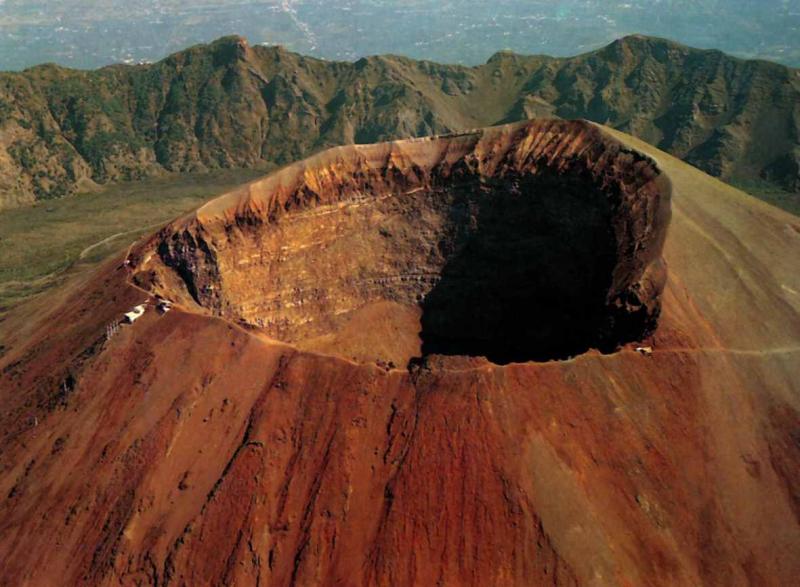Most famous for its 79 C.E. eruption, which devastated the Roman settlements of Pompeii and nearby Herculaneum, Mount Vesuvius is a volcano located in southern Italy that has violently erupted numerous times over the past four millenia, and it is the only volcano in Europe to have erupted within the past century. In the year 1995 B.C.E, Mount Vesuvius erupted with a volcanic explosivity index rating of 6, higher than the famous Pompeii eruption’s rating of 5, depositing large amounts of pyroclastic materials on the western side of the volcano, an event which is the source of the large pumice formations which surround the nearby town of Avellino; this event has consequently been called the “Avellino eruption”. During the eruption, nodules of the coarse grained rock syenite were ejected from the volcano; it is theorised that before the eruption, these nodules formed on the outer layer of the magma reservoir, which was cool enough to allow for the crystallisation of multiple mineral species, including zircon.
The cratered summit of Mount Vesuvius; Image: Italy Magazine
`Large numbers of naturally occuring blue zircon crystals have been discovered within the syenite nodules from the Avellino eruption, with these stones receiving some of their most recent scientific evaluations in 2021. These blue zircons were found to contain the same trace elements found in zircon crystals from Cambodia’s Ratanakiri province, including uranium (U), thorium (Th), hafnium (Hf), niobium (Nb), and rare earth elements like cerium (Ce) and neodymium (Nd), however the density of mineral inclusions in these stones is considerably higher than that of gem grade zircon crystals from southeast Asia. Interestingly, crystal zones which contained more densely packed inclusions appeared yellowish or brownish in transmitted light as opposed to the colourless appearance observed in other crystal zones; conversely, treated blue zircons from Cambodia appear light blue when viewed in transmitted light. In addition to the analysis of unaltered crystals, some of the Vesuvian blue zircons were also examined after receiving the same heat treatments that most commercial blue zircons are subjected to.
Blue zircon crystals on matrix from the San Vito Quarry on the western slopes of the Somma-Vesuvius Complex in Campania, Italy; Image: Mindat/ Lugi Chiappino
When heated under the same oxygenless conditions that produce the blue hues seen in heated zircon gemstones from Cambodia, the colour of blue zircon crystals from Mount Vesuvius did not intensify, however these stones did display yellowish tones after being heated in the presence of oxygen much like some heated zircons from southeast Asia; the yellow colour seen in the treated Italian material was most intense in crystal zones which contained higher concentrations of mineral inclusions. This could imply a degree of similar chemistry between the zircon crystals of Mount Vesuvius and some zircon crystals from southeast Asia. Following heat treatment, the Italian blue zircons were exposed to long wave ultraviolet light (LWUV) to test their tenebrescence and compare it with the tenebrescent shift that has been observed in some treated blue zircons from Asia; ultraviolet light exposure had no discernible effect on the colour of blue zircon crystals recovered from Mount Vesuvius, whereas LWUV can temporarily changed the colour of some treated blue zircons from Asia to a brownish hue.
Zircon crystals from Mount Vesuvius subjected to heat treatment under oxidising/reducing conditions and a treatment naive crystal viewed in reflected light (RL) and plane polarised light (PPL); Image: Sun et. al.
Similarities in chemistry and heat treatment results suggest that its plausible the colour of italian blue zircons and Asian blue zircons could be derived from the same source; earlier investigations suggest that the stones found in Italy were heated after formation by proximal magmatic activity, a possible explanation for the anecdotal reports of untreated blue zircon crystals in other locations as well. Differences in inclusion profiles, tenebrescence, and behaviour in transmitted light do however point to a different explanation for how the Vesuvian zircons got their colour; it has been more recently proposed that the blue colour seen in zircon crystals from the Avellino eruption is not caused by any sort of chromophore but is instead the result of light scattering, most likely Raleigh type light scattering, as blue zones of the Italian zircons only appeared blue when given oblique illumination rather than perpendicular transmitted light; light scattering is the same phenomenon that causes the sky to appear blue, and it is caused by the presence of finely dispersed dust particles in the air. In a manner similar to how dust in the atmosphere causes light scattering, the scattering of light in Vesuvian zircons is thought to occur because of the highly refractive inclusions that have been found dispersed throughout the stones.
A faceted blue zircon gemstone from Cambodia; Image: Skyjems
One of the Earth’s most underrated treasures, zircon gems are a fantastic addition to countless bespoke jewellery designs and almost any gemstone collection. Quintessential parts of the planet, zircon crystals are as important to science as they are beautiful. These mysteriously colourful stones continue to enliven the world with their brilliance, and should never be neglected or forgotten.
© Yaĝé Enigmus




